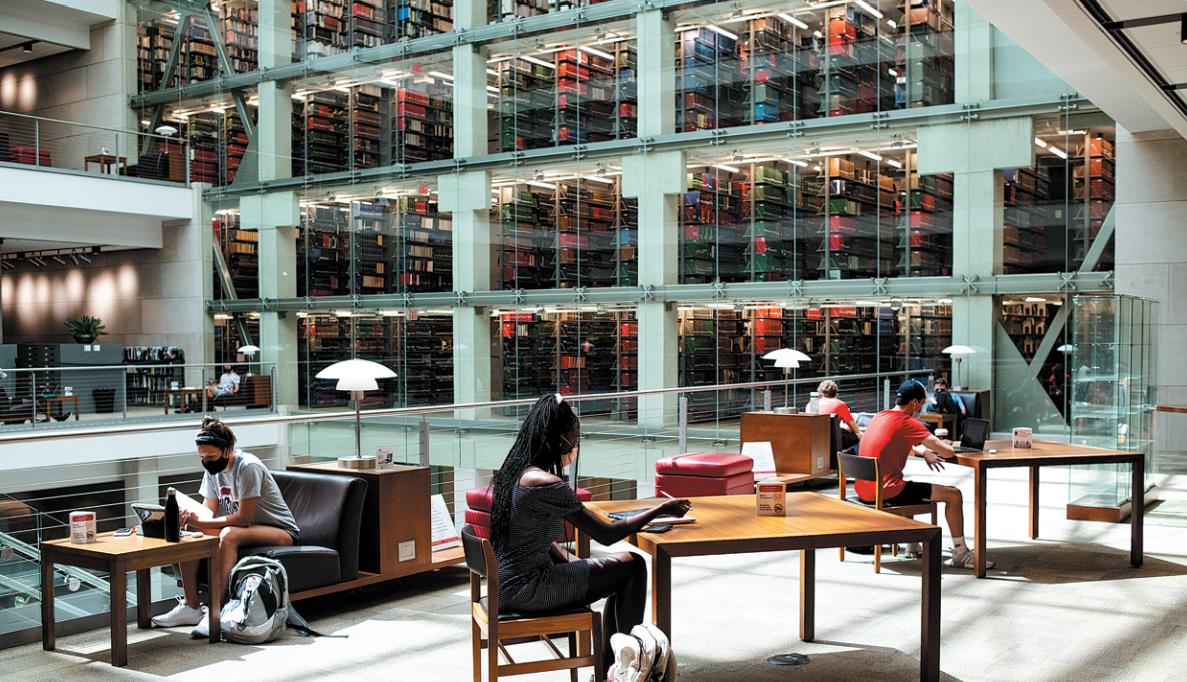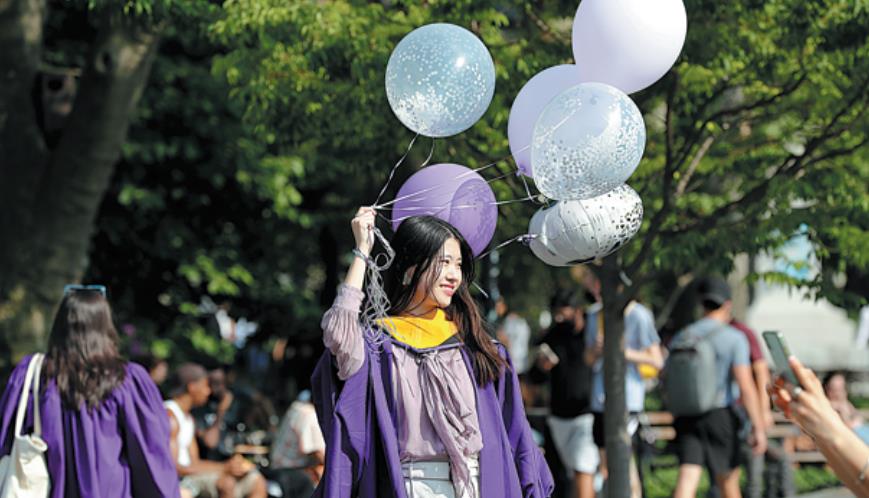
Students study in the library at Ohio State University in Columbus, Ohio, United States, last year. TY WRIGHT/BLOOMBERG/GETTY IMAGES
Overseas arrivals fall as universities face budget cuts and lose revenue
Despite his parents wanting him to go to a university in the United States, He Tianhao chose to further his studies in autonomous systems at a European institution after graduating from the University of California, San Diego last summer.
To prepare him for university, his parents sent him to an international high school in Beijing, where he said many students aimed to attend a US higher education institution.
"The university was great. The academic environment was great. The professors were great. Everything would be great if you could live on the campus forever," he said.
He arrived in the US in the fall of 2016. As a Chinese international student, he described his four years in the country as eventful.
There was the Trump administration's proposed visa ban on Chinese students, visa restrictions on such students in STEM(science, technology, engineering and mathematics) fields over "national security" concerns, and rising racism and violence against Chinese and other Asians due to the COVID-19 pandemic.
"My undergraduate major was machine learning-one of the hot areas under the government's scrutiny. Chinese graduate students in this field have to renew their visa every year. I heard that some have been stuck in China for several years," He said.
The pandemic further complicated the visa challenges. On Jan 31 last year, the Trump administration imposed a travel ban on non-citizens who were in China during the preceding 14 days. This ban remains in place, but in April, the Biden administration made exceptions for international students in China and other countries.
However, this was too late for Suzy Liu, who received notice for a visa appointment on May 4.
Under the exemption, international students can apply for visas if they attend universities for classes starting on Aug 1 or later. Liu is not eligible, as she has recently graduated from San Francisco State University.
She returned to China for a 10-day break in early January last year. "I never expected a short stay in China would change my career path forever," she said.
Liu planned to become a lecturer in Asian American studies at San Francisco State University after graduating this summer. Then, the pandemic emerged and US embassies and consulates worldwide were closed. Her visa appointments were canceled five times last year.
"There are many students like me. We have a WeChat group, in which we share information and help each other," she said.
Some students managed to transfer to universities in the United Kingdom, Liu said, and others planned to fly to Singapore or Canada to apply for a visa, before entering the US after 14 days' quarantine in the third country.
"After consideration, my family and I decided to give it up because I didn't want to risk being infected," said Liu, who has settled in Qingdao, Shandong province, as a translator.
Even if visa processing resumes, industry experts have voiced concern about the backlog of applications at US embassies and consulates after more than a year of reduced operations.
Last summer, only 160 student visas were processed in China, whereas in the previous three summers, more than 70,000 visas were handled, according to Open Campus, a non-profit news organization dedicated to higher education.
Andrew Hang Chen, vice-chair of the National Association for Foreign Student Advisers' China Member Interest Group, initiated an online petition to the US State Department, alerting it to what he called "the Chinese student visa crisis".
Without F-1 visa processing for Chinese students, their disappearance from US campuses in the 2021-22 academic year would be an imminent crisis, Chen said in the petition. NAFSA has since been renamed the Association of International Educators.
According to a report by the Institute of International Education, 90 percent of US universities are aiming for international students to return for the 2021-22 academic year by offering in-person classes, while since autumn, 77 percent of universities have shown strengthened commitment to recruiting international students.
But with visa challenges and pandemic-related restrictions, the question being debated is whether international enrollment at US colleges and universities will recover.

Students from New York University celebrate their graduation on May 19. LIAO PAN/CHINA NEWS SERVICE
Enrollment drop
Before the pandemic emerged, US higher education enrollment for domestic and international students had been declining.
With disruptions caused by COVID-19, enrollment fell to new lows in the spring, according to the National Student Clearinghouse Research Center. Overall spring enrollment dropped to 16.9 million from 17.5 million, marking a one-year fall of 3.5 percent, seven times worse than the decline a year earlier.
For two decades, US colleges and universities saw applications from international students rise annually, until the 2016-17 academic year.
China is the largest source of such students in the US. There were more than 372,000 Chinese students in the country during the 2019-20 academic year, one-third of the 1 million-plus international students in the country, according to the 2020 Open Doors report released by the Department of State's Bureau of Educational and Cultural Affairs and the Institute of International Education.
While the volume of international applicants to US higher education institutions increased this year, there was an 18 percent drop in applications from China last year, according to data in January from Common App, an undergraduate college admission application.
Krysty Shen, a graduate student at San Francisco State University, said anti-China rhetoric and racism were seen as important factors that deterred Chinese international students from going to the US. For her ethnic studies project, Shen interviewed Chinese students on how they spent the past year.
"I'm seeing this trend of Chinese international students choosing other places instead of the US, or recommending other places instead of the US," she said.
"One of the questions I asked my interviewees is if they would recommend others to come to the US for school. Their response was still 'yes', because a lot of American universities are at the top, but they also said people should understand that America is not as great as it's depicted, and they should have more of an understanding about the racism and history in the US," she said.
Brendan O'Brien, director of the International Students and Scholars Office at Iowa State University, told local newspaper the Iowa City Press-Citizen the factors contributing to a decline in international enrollment may include a perception that the US is now less welcoming to international students.
Suzy Liu, having lived in the US for seven years, including four years at the University of Colorado, said she felt Chinese students were increasingly unwelcome in the country.
The Trump administration intensified a crackdown on Chinese students and scholars by imposing visa restrictions in certain areas, cancelling visas for students with ties to the Chinese military, and tightening H-1B visas for highly skilled workers.
"One of the motivations in obtaining a US degree is the prospect of finding a job in that country, but I see an increasingly unfavorable attitude toward Chinese students and immigrants," Liu said.
In July last year, the Trump administration announced that international students at US educational institutions had to leave or would be prohibited from entering the country if their schools moved to online-only teaching in response to the pandemic.
In contrast, Canada and the UK opened their doors to Chinese students and even accelerated visa applications for them, Liu said. "In our WeChat group, many students said they were considering transferring to UK or Canadian universities, and some parents were hesitant about sending their children to the US," she added.
US public research universities stand to be affected the most by a decline in international student flows, as they have become increasingly dependent on tuition revenue from these students.
Since the Great Recession in the US more than a decade ago, different states have made significant cuts to higher education spending. Colleges and universities responded to the cuts by increasing tuition and began recruiting and admitting more high-paying international students.
For example, the University of California enrolled 15,046 international students in autumn 2010, and the number rocketed to 43,738 in autumn last year, including 25,600 from China. The 2020-21 tuition and other fees for in-state students at the university are $14,100 and those for international students are $43,900.
US higher education has been transformed by a marked rise in international enrollment since 2005, largely driven by students from China. Enrollment from China rose by 400 percent from 2005 to 2018, generating much needed revenue for universities often to the advantage of domestic students, a study by the Center for Global Development found.
Analysis by NAFSA found that international students across the US brought in $40.5 billion to colleges and universities in the 2018-19 academic year and nearly $39 billion in the 2019-20 year.
At the University of Iowa and Iowa State University, international student enrollment fell by nearly 25 percent in autumn last year, costing an estimated $11.5 million in tuition revenue for the two institutions. Citing financial losses due to the pandemic and "frozen state support", Iowa's Board of Regents is proposing tuition rises for the state's public universities in the coming academic year. Other US universities are also proposing budget cuts.

Michelle Lee, left, a doctor, and Ida Chen, an assistant physician student, prepare posters on April 24 in New York's Chinatown to protest anti-Asian hatred. BEBETO MATTHEWS/AP
Brain drain
Trade wars between the US and China have exacerbated the decline in international enrollment. The trade conflicts could cost US universities around 30,000 Chinese students in the next 10 years-a loss of $1.15 billion in tuition revenue-researchers warned in the study by the Center for Global Development.
Peter Leroe-Munoz, general counsel and vice-president of innovation and technology at Silicon Valley Leadership Group, said, "China is the largest source of international students to the United States, and this closing-off of that avenue of education for Chinese students represented a massive loss in collaborative brainpower.
"Nearly one in six STEM workers in Silicon Valley was born in China, and many more are of Chinese descent," said Leroe-Munoz, whose organization represents nearly 400 Silicon Valley companies. "If we oust these students, they end up in countries that compete against the United States in the global economy."
He said policymakers should do a better job of recognizing the contributions of Asian Americans and Chinese nationals to the success of the US innovation economy.